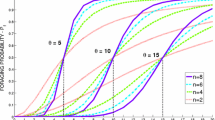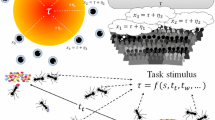Abstract
In this paper, we investigate how response probability may be used to improve the robustness of reactive, threshold-based robotic swarms. In swarms where agents have differing thresholds, adding a response probability is expected to distribute task experiences among more agents, which can increase the robustness of the swarm. If the lowest threshold agents for a task become unavailable, distributing task experience among more agents increases the chance that there are other agents in the swarm with experience on the task, which reduces performance decline due to the loss of experienced agents. We begin with a mathematical analysis of such a system and show that, for a given swarm and task demand, we can estimate the response probability values that ensure team formation and meet robustness constraints. We then verify the expected behavior on an agent based model of a foraging problem. Results indicate that response probability may be used to tune the tradeoff between system performance and system robustness.










Similar content being viewed by others
Notes
Includes perceived local or global swarm status.
Von Neumann neighborhood with radius one.
For example, by incorporating individual memory maps into a central map at the nest that is shared with all agents.
Although the runs begin with \(n=200\), four losses (of 20 agents each) drops the swarm size down to \(n=120\) for the entire second half of a run.
References
Agassounon, W., Martinoli, A., & Goodman, R. (2001). A scalable distributed algorithm for allocating workers in embedded systems. In Proceedings of the IEEE international conference on systems, man, and cybernetics (pp. 3367–3373).
Ashby, W. R. (1958). Requisite variety and its implications for the control of complex systems. Cybernetica, 1(2), 83–99.
Bonabeau, E., Theraulaz, G., & Deneubourg, J. (1996). Quantitative study of the fixed response threshold model for the regulation of division of labour in insect societies. Proceedings of the Royal Society of London B, 263, 1565–1569.
Bonabeau, E., Theraulaz, G., & Deneubourg, J. (1998). Fixed response thresholds and the regulation of division of labor in insect societies. Bulletin of Mathematical Biology, 60, 753–807.
Brambilla, M., Ferrante, E., Birattari, M., & Dorigo, M. (2013). Swarm robotics: A review from the swarm engineering perspective. Swarm Intelligence, 7, 1–41.
Brutschy, A., Pini, G., Pinciroli, C., Birattari, M., & Dorigo, M. (2014). Self-organized task allocation to sequentially interdependent tasks in swarm robotics. Autonomous Agents and Multi-Agent Systems, 28(1), 101–125.
Brutschy, A., Tran, N.-L., Baiboun, N., Frison, M., Pini, G., Roli, A., et al. (2012). Costs and benefits of behavioural specialization. Robotics and Autonomous Systems, 60(11), 1408–1420.
Campos, M., Bonabeau, E., Theraulaz, G., & Deneubourg, J. (2000). Dynamic scheduling and division of labor in social insects. Adaptive Behavior, 8(2), 83–96.
Castello, E., Yamamoto, T., Dalla Libera, F. D., Liu, W., Winfield, A. F. T., Nakamura, Y., & H. Ishiguro (2016). Adaptive foraging for simulated and real robotic swarms: The dynamical response threshold approach. Swarm Intelligence, 10(1), 1–31.
Castello, E., Yamamoto, T., Nakamua, Y., & Ishiguro, H. (2013). Task allocation for a robotic swarm based on an adaptive response threshold model. In Proceedings of the 13th IEEE international conference on control, automation, and systems (pp. 259–266). IEEE.
Cicirello, V. A., & Smith, S. F. (2002). Distributed coordination of resources via wasp-like agents. In Workshop on Radical Agent Concepts, LNAI (Vol. 2564, pp. 71–80). Springer.
Correll, N. (2008). Parameter estimation and optimal control of swarm-robotic systems: A case study in distributed task allocation. Proceedings of the IEEE international conference on robotics and automation (pp. 3302–3307). IEEE.
de Lope, J., Maravall, D., & Quinoñez, Y. (2013). Response threshold models and stochastic learning automata for self-coordination of heterogeneous multi-task distribution in multi-robot systems. Robotics and Autonomous Systems, 61, 714–720.
dos Santos, F., & Bazzan, A. L. C. (2009). An ant based algorithm for task allocation in large-scale and dynamic multiagent scenarios. In GECCO '09: Proceedings of the 11th Annual conference on Genetic and evolutionary computation (pp. 73–80).
Goldingay, H., & van Mourik, J. (2013). The effect of load on agent-based algorithms for distributed task allocation. Information Sciences, 222, 66–80.
Goss, S., Aron, S., Deneubourg, J. L., & Pasteels, J. M. (1989). Self-organized shortcuts in the Argentine ant. Naturwissenschaften, 76, 579–581.
Goss, S., Beckers, R., Deneubourg, J. L., Aron, S., & Pasteels, J. M. (1990). How trail laying and trail following can solve foraging problems for ant colonies. In R. N. Hughes (Ed.), Behavioural mechanisms of food selection (Vol. 20, pp. 661–678). Berlin: Springer.
Kanakia, A., Touri, B., & Correll, N. (2016). Modeling multi-robot task allocation with limited information as global game. Swarm Intelligence, 10(2), 147–160.
Kazakova, V. A. & Wu, A. S. (2018). Specialization vs re-specialization: Effects of Hebbian learning in a dynamic environment. In Proceedings of the 31st international Florida artificial intelligence research society (pp. 354–359). AAAI.
Kittithreerapronchai, O., & Anderson, C. (2003). Do ants paint trucks better than chickens? Market versus response threshold for distributed dynamic scheduling. In Proceedings of the 2003 Congress on Evolutionary Computation (pp. 1431–1439). IEEE.
Krieger, M. J. B., & Billeter, J. (2000). The call of duty: Self-organised task allocation in a population of up to twelve mobile robots. Robotics and Autonomous Systems, 30, 65–84.
Krieger, M. J. B., Billeter, J., & Keller, L. (2000). Ant-like task allocation and recruitment in cooperative robots. Nature, 406, 992–995.
Labella, T. H., Dorigo, M., & Deneubourg, J. (2006). Division of labor in a group of robotics inspired by ants’ foraging behavior. ACM Transactions on Autonomous and Adaptive Systems, 1(1), 4–25.
Lee, W., & Kim, D. (2017). History-based response threshold model for division of labor in multi-agent systems. Sensors, 17(6), 1232.
Lerman, K., Jones, C., Galstyan, A., & Mataric, M. (2006). Analysis of dynamic task allocation in multi-robot systems. International Journal of Robotics Research, 25, 225–241.
Merkle, D., & Middendorf, M. (2004). Dynamic polytheism and competition for tasks in threshold reinforcement models of social insects. Adaptive Behavior, 12(3–4), 251–262.
Motwani, R., & Raghavan, P. (1995). Randomized algorithms. Cambridge: Cambridge University Press.
Niccolini, M., Innocenti, M., & Pollini, L. (2010). Multiple UAV task assignment using descriptor functions. In Proceedings of the 18th IFAC symposium on automatic control in aerospace (pp. 93–98).
Nouyan, S. (2002). Agent-based approach to dynamic task allocation. In ANTS 2002, Third International Workshop on Ant Algorithms (pp. 28–39). Springer.
Nouyan, S., Ghizzioli, R., Birattari, M., & Dorigo, M. (2005). An insect-based algorithm for the dynamic task allocation problem. Kunstliche Intelligenz, 4(5), 25–31.
Pang, B., Zhang, C., Song, Y., & Wang, H. (2017). Self-organized task allocation in swarm robotics foraging based on dynimcal response threshold approach. In Proceedings of the 18th international conference on advanced robotics (pp. 256–261). IEEE.
Pini, G., Brutschy, A., Frison, M., Roli, A., Dorigo, M., & Birattari, M. (2011). Task partitioning in swarms of robots: An adaptive method for strategy selection. Swarm Intelligence, 5(3–4), 283–304.
Pini, G., Brutschy, A., Pinciroli, C., Dorigo, M., & Birattari, M. (2013). Autonomous task partitioning in robot foraging: An approach based on cost estimation. Adaptive Behavior, 21(2), 118–136.
Pini, G., Brutschy, A., Scheidler, A., Dorigo, M., & Birattari, M. (2014). Task partitioning in a robot swarm: Object retrieval as a sequence of subtasks with direct object transfer. Artificial Life, 20(3), 291–317.
Pini, G., Gagliolo, M., Brutschy, A., Dorigo, M., & Birattari, M. (2013). Task partitioning in a robot swarm: A study on the effect of communication. Swarm Intelligence, 7(2–3), 173–199.
Pradhan, R., & Wu, A. S. (2011). On the relationship between response probability and redundancy in teams of collaborating agents. In Proceedings of the 5th international conference on collaborative computing: networking, applications, and worksharing. IEEE.
Price, R., & Tino, P. (2004). Evaluation of adaptive nature inspired task allocation against alternate decentralised multiagent strategies. In Proceedings of the international conference on parallel problem solving from nature, LNCS (Vol. 3242, pp. 982–990). Springer.
Scerri, P., Farinelli, A., Okamoto, S., & Tambe, M. (2005). Allocating tasks in extreme teams. In Proceedings of the international conference on autonomous agents and multi-agent systems (pp. 727–734). ACM.
Weidenmüller, A. (2004). The control of nest climate in bumblebee (bombus terrestris) colonies: Interindividual variability and self reinforcement in fanning response. Behavioral Ecology, 15(1), 120–128.
Winfield, A. F . T. (2013). Foraging robots. In R . A. Meyers (Ed.), Encyclopedia of complexity and systems science (pp. 3682–3700). Berlin: Springer.
Wu, A. S., & Kazakova, V. A. (2017). Effects of task consideration order on decentralized task allocation using time-variant response thresholds. In Proceedings of the 30th international Florida artificial intelligence research society (pp. 466–471). AAAI.
Wu, A. S., & Riggs, C. (2018). Inter-agent variation improves dynamic decentralized task allocation. In Proceedings of the 31st international Florida artificial intelligence research society (pp. 366–369). AAAI.
Wu, A. S., Wiegand, R. P., & Pradhan, R. (2016). Building redundancy in multi-agent systems using probabilistic action. In Proceedings of the 29th international Florida artificial intelligence research society conference (pp. 404–409). AAAI.
Wu, A. S., Wiegand, R. P., Pradhan, R., & Anil, G. (2012). The effects of inter-agent variation on developing stable and robust teams. In Proceedings of the AAAI spring symposium. AAAI.
Yamauchi, B. (1998). Frontier-based exploration using multiple robots. In Proceedings of the 2nd international conference on autonomous agents (pp. 47–53). ACM.
Yang, Y., Chen, X., & Li, Q. (2010). Swarm robots task allocation based on local communication. In Proceedings of the international conference on computer, mechatronics, control, and electronic engineering (pp. 415–418). IEEE.
Acknowledgements
This work was supported in part by NSF Grant IIS1816777 and ONR Grant N000140911043.
Author information
Authors and Affiliations
Corresponding author
Additional information
Publisher's Note
Springer Nature remains neutral with regard to jurisdictional claims in published maps and institutional affiliations.
Rights and permissions
About this article
Cite this article
Wu, A.S., Wiegand, R.P. & Pradhan, R. Response probability enhances robustness in decentralized threshold-based robotic swarms. Swarm Intell 14, 233–258 (2020). https://doi.org/10.1007/s11721-020-00182-2
Received:
Accepted:
Published:
Issue Date:
DOI: https://doi.org/10.1007/s11721-020-00182-2




